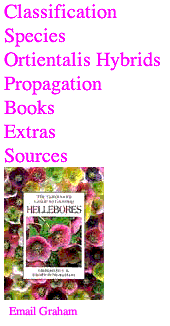
 |
In general, hellebores prefer neutral or slightly limy soils; a pH of about 7.0 seems ideal although good plants are often also seen around rhododendrons in gardens with acid conditions. Acid soil can be made more accommodating by liming the whole area before planting, using an alkaline organic material such as spent mushroom compost when improving the soil, or by adding 1-2oz/30-60gm of lime to the planting mix (see page xxx) when planting individual plants. An annual top dressing of 1-2oz/30-60gm of lime per plant, before mulching, can also help. And on very acid soils, even the rhododendrons will appreciate a little lime.
Recommendations for individual species, but it is fortunately true that all types of soil can grow good plants although all hellebores hate waterlogged soil. In severe cases waterlogging can be alleviated by installing drainage; working organic matter and grit into the soil to improve the flow of water to lower levels can also be successful and creating raised beds also works well. Planting near to mature trees which naturally remove a great deal of moisture from soggy soil is a clever ecological solution for shade lovers.
In general, the more moisture the soil retains the more sun and open exposure hellebores will tolerate. On heavy clay soils, which tend to be moisture retentive, most will take some sunshine but the plants, and their neighbours, will still benefit from soil improvement.
Organic matter is, as usual, the key but the addition of coarse grit can also improve heavy soil. Thorough winter digging in the traditional style allows both grit and organic matter to be incorporated; forking these materials into the second spit will create noticeable improvements to the workability of the soil and the health of the plants. Well-rotted garden compost, well-rotted manure, leaf mould, spent mushroom compost, bagged soil improvers from the garden centre are all suitable forms of organic matter.
In sandier, well-drained soil the plants appreciate more shade. The addition of generous amounts of organic matter will greatly improve both the moisture holding capacity and the nutrient levels of the soil.
Planting
But improving the general soil is only part of the answer. Preparing thoroughly before planting individual plants is also very important. Plants of H. hybridus in particular develop deep and extensive root systems which allow them access to potential reserves of moisture and nutrients deep in the soil. So when planting it pays to prepare well. As it is not necessary, indeed it is a mistake, to split the plants regularly as is usual with many other perennials the plants will remain in the one site for many years developing into large and impressive clumps. So planting time is the one opportunity to improve the soil at root level.
Dig out a hole to the depth of your spade and 18in/45cm across; fork over the base of the hole and then work in some friable organic matter. The most generally available material is old peat-based or soil-based potting or container compost or the contents old growing bags; but the truth is that anything is better than nothing. Add to this a long term slow release fertiliser, and some grit on poorly drained soils. Work at least half a bucket of this mix into the base of the hole, then tread firmly. If the general planting area has been hurriedly prepared or if organic matter could not be applied liberally in general preparation, work some more planting mix into the soil which will be used to refill the hole.
The level of planting is important. Pot grown plants can simply be planted so that the surface of the compost in the pot is level with the surrounding soil. Plants moved from elsewhere in the garden should be set so that the final soil level is 1in/2.5cm above the point at which the roots are attached to the crown.
Refill the hole with soil, tread carefully with the ball of your foot, level off and water in well. I like to water the plants with a liquid feed the day before planting and add some liquid feed to the can when watering in afterwards. Finish with a 2in/5cm mulch of weed free organic matter.
Plants of H. hybridus and many of the smaller species will stay undisturbed for many years so thorough preparation is essential. Shorter lived species such as H. argutifolius and H. foetidus will thrive on less preparation. H. vesicarius (page xxx) demands warm, sunny and well drained conditions, while H. lividus and to a lesser extent H. x sternii are also different in requiring better drainage and more sunshine. See their entries for details.